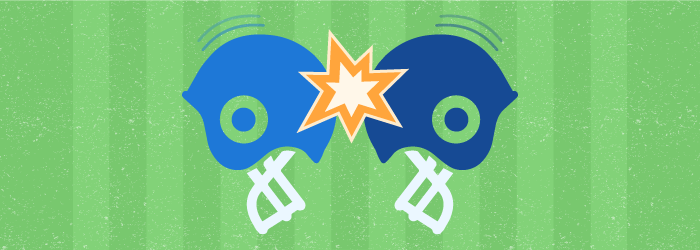Objective Evaluation of Sports Concussion

The team is down by one touchdown as the fourth quarter clock quickly counts down. Tick. Tock.
The first ever trip to the high school’s state finals is on the line. The star running back, and arguably the best athlete in the school, successfully takes on two linemen to achieve a first down deep into the opponent’s territory. But he is slow to get up and back into the huddle. He takes a knee at the side of the huddle and the officials call the medical staff onto the field. Of course, he says he feels fine and can continue to play, but since play has been stopped, he must be removed from the game for evaluation. One of the side judges tells you he was struck on top of the helmet. There is concern he has suffered a concussion.
The Evaluation
There is a standard procedure put into place at your school for situations just like this: Athletes are taken away from the sidelines for a quiet evaluation. The athlete clearly knows where he is playing, what the score is, and has good recall for last week’s game and school events. However, his balance seems poor and he is slow to respond to questions. As the evaluation continues, voices from the stands can be heard yelling that the game is moving fast. Voices and tension gets louder when the running back coach is now standing there with a quizzical look on his face: “Can he return to the game yet?”
The evaluation continues. Thoughtfully, carefully each step is completed. The athlete is not comfortable looking up at the bright lights ringing the stadium. He cannot tell you the months backward. The player cannot remember the words given to him at the onset of the evaluation. He now has a glassy, distant appearance. “I’m fine!” he insists. “I’m good to go.”
You can feel the stares of students and parents alike anxiously waiting in the stands. He clearly has a concussion. He will not be returning to the game.
Fortunately, before the season started, a team meeting with parents, coaches, and athletes was conducted regarding mild traumatic brain injuries and how they would be evaluated and managed to prepare for moments just like this. Everyone understood the way injuries would be handled: how evaluations would be conducted and who would make the decision regarding return to play. A detailed explanation was given on why treating concussion this way is important for the long term health of an athlete’s brain. Everyone understood this may happen, at this time, to this player, in this game.
As the decision is shared with coaches and the athlete’s parents, all are in agreement. Attention returns to the field as a touchdown is scored to tie the game.
The Lesson
There are obviously questions after the game. When will he return to play? What needs to happen in the next 24 hours? What about the rest of the weekend? Will he be ok to play again at all? What can the family do? All questions are answered and a plan is put into place for the weekend.
This is a scenario played out on sporting fields everyday around the world. Managing concussions has become the most important sports injury of this decade. Are you prepared to deal with these injuries in the clinic or sideline?
Objective Exam
Having an objective exam that takes the emotion out of play is a crucial step in evaluating injured athletes. We all want our athletes to play in the game and we all want to win, but there are times when a clinician needs to be emotionally detached from the event.
Having a plan, a step-by-step approach, to evaluation on the sideline will help take the emotion out of the situation. This evaluation should include:
- Objective measures of cognition, memory, balance, and orientation
- A critical review of symptoms – simply asking if the athlete has a headache or dizziness will not suffice
- Some level of exertion to see if this elicits any symptoms
With a good plan in place, the emotion of the game will not distract the clinician and allow a missed diagnosis that may put the athlete at increased risk of injury.

